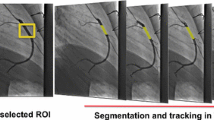Abstract
A problem of cyclic movement of measurement field (artery segment) occurs in the approaches focused on coronary flow measurement based on densitometric analysis of coronarographic images. The realized algorithm of automatic artery segment tracking based on template matching method makes possible to trace the results of automatic detection of characteristic points within the structure of arteries, correction of fault matching and incorporation of received movement trajectories for analysis of both the sequence range, where there occurs the lack of X-ray indicator within the tested artery fragment (so its not visible on the screen) and the part of myocardium, close to the characteristic point, what makes possible to the myocardium perfusion estimation on the basis of coronarographic images. Estimated error of the automatic analysis is less than 11%. Introduced system is acceptable for routine clinical testing due to short time for sequence analysis.
Access this chapter
Tax calculation will be finalised at checkout
Purchases are for personal use only
Preview
Unable to display preview. Download preview PDF.
Similar content being viewed by others
References
Goszczyńska H, Kowalczyk L, M. Rewicki (2006) Clinical study on the coronary flow measurement method based on the coronarographic images. Biocybernetics and Bioengineering, 26:63–73.
Goszczyńska H, Podsiadly T (2006) Flow rate calculation method based on coronarographic images: method error estimation. Springer IFMBE Proc. 14: 1–4.
Meijering E (2000) Image Enhacement in digital X-ray angiography, PhD Thesis, University Medical Center, Utrecht
Coatrieux J-L et al (1995) 2D et 3D Motion Analysis in Digital Subtraction Angiography, Computer Vision, Virtual Reality and Robotics in Medicine, (Ayache N. ed.), Springer, CVRMed
Konrad J (2000) Motion Detection and Estimation,. In Al Bovik (ed) Handbook of Image& Video Processing. Academic Press, San Diego
Buzug TM, Weese J, Strasters KC (1998) Motion detection and motion compensation for digital subtraction angiography image enhancement, Philips J. Res. 51:203–229.
Orkisz M et al (1999) Real-time target tracking applied to improve fragmentation of renal stones in extra-corporeal lithotripsy Machine Vision and Applications 11:138–144.
Benayoun S, Ayache N, (1998) “Dense Non-Rigid Motion Estimation In Sequence of Medical Images Using Differential Constraints”, Int. Journal of Computer Vision Kluwer Academic Publishers 26:25–40.
Bogorodzki P, Wolak T, Pitkowski A (2000) “Real Time Implementation of the Parametric Imaging Correlation Algorithms”, 59th MCB Seminar on Recent Development in MR Imaging, Warsaw
Fei R, Gui L, Merzkirch W (1999) Comparative study of correlation-based PIV evaluation methods, Machine Graphics&Vision 8:572–578.
Meijering EHW, Nissen WJ and Viergever MA (1999) Retrospective motion correction in digital subtraction angiography: a review IEEE Trans. Med. Imaging, 18:2–21.
Young AA, Hunter PJ, Smaill BH (1992) “Estimation of epicardial strain using the motions of coronary bifurcations in biplane cineangiography”, IEEE Trans. Biomed. Eng., 39(5), pp. 526–531.
Meunier J et al (1989) Analysis of cardiac motion from coronary cineangiograms: Velocity field computation and decomposition SPIE 1090
Rong JH (1989) Estimation et caracterisation du mouvement en coronarographie. PhD Thesis, l’Universite de Rennes I
Schrijver M (2002) Angiographic Image Analysis to Assess the Severity of Coronary Stenoses, Twente University Press, Enschede
Author information
Authors and Affiliations
Editor information
Editors and Affiliations
Rights and permissions
Copyright information
© 2007 Springer-Verlag Berlin Heidelberg
About this paper
Cite this paper
Goszczyńska, H. (2007). Movement Tracking of Coronary Artery Segment in Angiographic Images Sequences by Template Matching Method. In: Kurzynski, M., Puchala, E., Wozniak, M., Zolnierek, A. (eds) Computer Recognition Systems 2. Advances in Soft Computing, vol 45. Springer, Berlin, Heidelberg. https://doi.org/10.1007/978-3-540-75175-5_78
Download citation
DOI: https://doi.org/10.1007/978-3-540-75175-5_78
Publisher Name: Springer, Berlin, Heidelberg
Print ISBN: 978-3-540-75174-8
Online ISBN: 978-3-540-75175-5
eBook Packages: EngineeringEngineering (R0)




